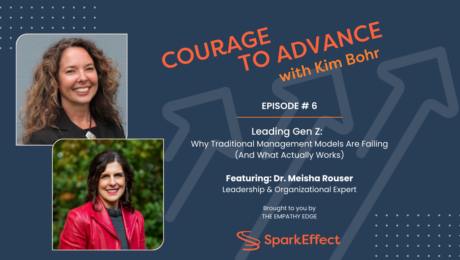Key Insights from SparkEffect's Thrive Community Event
In a business landscape where burnout affects 64% of employees weekly and only 30% of workers report feeling engaged, understanding the human element of organizational change has never been more critical. This pressing need was the focus of SparkEffect’s recent Thrive Community virtual lunch + learn session, “The Human Side of Change,” featuring Executive Coach Courtney Birch Webster and hosted by Kristie Winchester, VP of Client Engagement at SparkEffect.
The Iceberg of Change: What Lies Beneath
“Change is like an iceberg – 90% happens beneath the surface,” explained Courtney Birch Webster during her presentation. This powerful metaphor set the tone for a conversation that went far beyond typical change management discussions about process updates, new structures, or system implementations.
While organizations often focus on the visible aspects of change (the 10% above the waterline), the session emphasized how success ultimately depends on addressing what’s happening beneath: emotions, identity shifts, uncertainty, and resistance.
As Webster noted, “We’ve all seen change initiatives that looked perfect on paper but failed because we forgot to address what’s going on below the waterline.” What’s below the surface is the human side of the change—the emotions, feelings and uncertainty.
The Change Continuum: Understanding Transitions
A centerpiece of the session was the William Bridges Transition Model, which maps the psychological journey people experience during change through three key phases:
- Endings & Letting Go: This initial phase often challenges those implementing change, as people must process feelings about departing from familiar routines, relationships, and ways of working.
- The Neutral Zone (or “Messy Middle”): Described as the period when “the old way is gone, but the new way isn’t really fully operational yet,” this phase can feel chaotic and disorienting but also offers unexpected opportunities.
- New Beginnings: The final phase where people start to embrace change both intellectually and emotionally, though not everyone reaches this stage simultaneously.
The model normalizes the discomfort and varied emotions that accompany change, providing a framework for understanding one’s own reactions and supporting others.
The "Messy Middle": Turning Chaos into Opportunity
One of the most compelling insights from the session emerged around the neutral zone or “messy middle” of transition. Kristie Winchester shared a quote from Susan Bridges that reframes this challenging period: “The essence of life takes place in the neutral zone phase of transition. It is in that interim spaciousness that all possibilities, creativity, and innovative ideas can come to life and flourish.”
Several HR leaders shared experiences that reinforced this perspective. One participant described how a struggling technology implementation ultimately led to innovation because teams were forced to solve problems creatively. Another shared how gathering employee feedback during a seemingly chaotic period of transition helped transform systems that weren’t working.
The key lesson? Rather than rushing through discomfort, organizations can leverage the neutral zone as a space for creativity and problem-solving when properly supported.
Practical Strategies for HR Leaders
Throughout the session, participants exchanged valuable tactics for managing the human side of change:
Recognize Different Rates of Adaptation
A critical insight came from an HR leader who identified their own tendency to adapt quickly while leading others through change. This awareness led to the important recognition that “normalizing change is not the same for everybody,” and requires understanding the needs of different stakeholders who progress at varying paces.
Create Stakeholder-Specific Communication
The “one-size-fits-all” approach to change communication often fails. Session participants discussed the value of creating targeted messages that address “what’s in it for me” for different roles, functions, and levels within the organization. While time-consuming, this approach significantly accelerates adaptation to change.
Address Both Benefits and Challenges
Several participants emphasized the importance of acknowledging frustrations alongside positive aspects of change. As one HR professional noted, “If you only focus on the positives, people feel unheard.” Validating concerns while highlighting progress creates psychological safety that accelerates transition.
Prepare People Managers First
A crucial strategy shared was ensuring front-line managers have time to process change before leading their teams through it. “Allowing managers to process feelings and move through the peaks and valleys enables them to more tactfully manage their people through the process,” explained one participant.
Focus on the Why
During extended periods of challenging change, repeatedly connecting back to the fundamental purpose helps maintain momentum. Examples were shared of how teams navigating difficult implementations benefited from consistent reminders of the ultimate goals and benefits.
Supporting Engagement During Change
The session concluded with practical recommendations for maintaining engagement during transitions:
- Increase connection: Enhance the frequency of check-ins during periods of change
- Acknowledge emotions: Slow down to recognize the thoughts and feelings others are experiencing
- Communicate transparently: Keep employees informed with frequent updates to remove uncertainty
- Utilize coaching: Employ coach-like conversations, especially with senior-level managers
- Celebrate incremental wins: Recognize progress along the change journey, not just at the end
As Courtney Birch Webster emphasized, “We’re humans. We need to process. We need to metabolize the emotions that are happening while change is happening.”
The Business Case for Human-Centered Change
Beyond the emotional aspects, the session highlighted compelling business reasons to focus on the human side of change. With current workplace statistics showing historically high disengagement, addressing the emotional and psychological aspects of transitions directly impacts organizational performance.
Organizations that effectively support employees through change see better adoption of new processes, faster returns on technology investments, and stronger retention during periods of transformation.
Moving Forward
Organizations that effectively support employees through change see better adoption of new processes, faster returns on technology investments, and stronger retention during periods of transformation.
As workplaces continue navigating significant shifts in 2025—from economic uncertainty to AI integration and evolving work models—the human elements of change will only grow more important. By recognizing where employees are in their individual change journeys, creating psychologically safe spaces for authentic conversation, and normalizing the emotional aspects of transition, organizations can transform potential resistance into constructive adaptation.
“This isn’t about dwelling in the past,” Webster noted. “It’s about honoring people’s experiences so that we can move forward together.”
Looking to Connect with HR Peers?
SparkEffect’s Thrive Community offers regular FREE events for HR leaders to connect, share best practices, and gain practical insights for navigating today’s complex workplace challenges. AND follow SparkEffect on LinkedIn for information on upcoming sessions.






